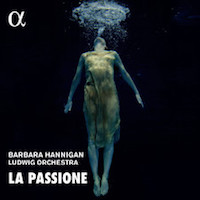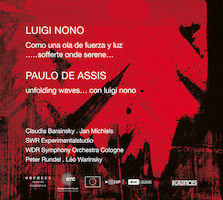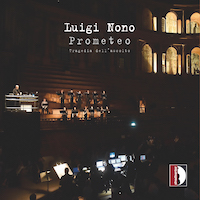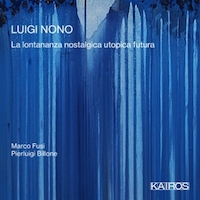Maestro di Suoni e Silenzi: Necessary Nono 6.
|
Grant Chu Covell [July 2022.] Continuing a recently started journey through the Nono backlog. The political missives reflect a composer with convictions, but they alienated many. The merest whisper of Communism immediately doomed any artist in the US, and Nono was vociferous. However, the later works dropped the sloganeering, although the music maintained its unforgiving intensity. It would seem Nono continued to be frustrated with the world, and that he implores us to do better, and, crucially, to listen better and to participate better.
“La Passione.” Luigi NONO: Djamila Boupacha from Canti di vita e d’amore (1962)1. Franz Joseph HAYDN: Symphony No. 49 in F minor, “La Passione” (1768)2. Gérard GRISEY: Quatre Chants pour Franchir le Seuil (1997-98)3. Barbara Hannigan1,3 (sop), Ludwig Orchestra2,3, Barbara Hannigan2,3 (cond.). Alpha 586 (1 CD) (www.outhere-music.com). The center movement from Nono’s Canti di vita e d’amore is for soprano alone, the text is pulled from Jesús López Pacheco’s Esta noche. In context, Djamila Boupacha, arrives after the thunder of full orchestra with two voices (soprano and tenor) in Sul ponte di Hiroshima. A solo for soprano suggests a cadenza, but in context the isolated solo minutes are calming. Hannigan’s program revolves around a propulsive reading of Haydn’s Symphony No. 49 which bridges the brief Nono solo and Grisey’s last completed work astonishingly well. Despite Haydn’s digestible Classicism, “La Passione” can be severe with an emotional Adagio followed by a mighty Sturm und Drang Allegro. Hannigan relates Nono’s giant leaps to Haydn’s dramatic lurches. Grisey’s Quatre Chants chills to the bone.
Luigi NONO: Como una ola de fuerza y luz (1971-72)1; …sofferte onde serene… (1975-77)2. Paulo DE ASSIS: unfolding waves… con luigi nono (2012)3. Claudia Barainsky1 (sop), Jan Michiels1,2 (pno), André Richard1, Reinhold Braig1, Paulo de Assis2 (sound projection), SWR Experimentalstudio1, WDR Sinfonieorchester1,3, Peter Rundel1,3, Léo Warinsky3 (cond.). Kairos 0015022KAI (1 CD) (www.kairos-music.com). Compared to his peers, who used the piano as a laboratory for innovation, Nono rarely included the keyboard instrument. Perhaps continuing in a long line of Venetians, his discoveries were conducted with voices. Stemming from a friendship with Maurizio Pollini, two works emerged in the 1970s where the piano is something of a soloist. Nono did not create concertos: The piano is equal partner to soprano, tape and orchestra in Como una ola de fuerza y luz, and in …sofferte onde serene…, the piano fuses with pre-recorded tape (containing Pollini’s recorded sounds). Both are blindingly angry. Como una ola de fuerza y luz is one of Nono’s potent political works (ok, none of the political works are subtle). In early 1971 Nono visited Chile, getting to know musicians and politicians including Luciano Cruz Aguayo who died under suspicious circumstances later that year. Nono and Pollini had been exploring piano sounds together, and upon hearing of Aguayo’s death, something like a requiem evolved. …sofferte onde serene… appeared after an intense period of reflection. It may appear not to be political, but it is as equally intense as Como una ola de fuerza y luz. Nono’s piano writing is not conventionally virtuosic, lacking runs and showy gestures, but it is rhythmically intricate, requiring accuracy and unusual chords. This release utilizes tapes modernized by Paulo de Assis. The booklet includes a single-page multi-colored analysis of Como una ola de fuerza y luz which clarifies how Nono allocates pitch material across the soloists, orchestra and tape. This …sofferte onde serene… is lighter and ghostlier if such a thing is possible. De Assis has thought about the balance between piano and tape, and how a pianist can follow Nono’s score but also diverge significantly from Pollini’s benchmark recording. The updated tape offers a wrinkled surface, sometimes at the edges, sometimes at the forefront. A similarity to the variety of interactions between violin and tapes of La lontananza nostalgica utopica futura emerges which had been obscured before. De Assis’ investigations led him to craft unfolding waves… con luigi nono which is essentially an orchestration of …sofferte onde serene…. De Assis created a work for three orchestral groups, a large orchestra representing the piano and two smaller ensembles representing the tape. De Assis calls his process “transcoding.” The thick palette is consistent with early Nono (e.g. Canti di vita e d’amore), but also not unlike a grouchy Berg or Varèse storming around Darmstadt in the late 1950s. The orchestra conveys Nono’s jabbing rhythms, the dissonant piano texture is variously translated into low brass, high winds or brittle percussion. I don’t think Nono would have created an orchestral piece like this at that time. The consistency in piano timbre and its tape mutations seemed to be …sofferte onde serene…’s target. The orchestra version can still throw punches and perturb. It’s worth a listen. De Assis offers his research materials, including scores and videos.
Luigi NONO: Prometeo, Tragedia dell’ascolto (1981-85). Livia Rado, Alda Caiello (sop), Katarzyna Otczyk, Silvia Regazzo (c-alt), Marco Rencinai (ten), Sergio Basile, Manuela Mandracchia (speakers), Alvise Vidolin, Nicola Bernardini (electronics), Ensemble Prometeo: Giulio Francesconi (fl), Roberta Gottardi (clar), Valentino Spaggiari (tuba), Gabriele Croci (vla), Claude Hauri (vlc), Emiliano Amadori (cbs), Filarmonica Arturo Toscanini, Coro del Teatro Regio di Parma, Marco Angius, Caterina Centofante (conds.). Stradivarius STR 37096 (2 SACDs) (www.stradivarius.it). Active listening is a difficult business. Personally, I shy away from Prometeo because it is so daunting and imposing. But after taking the plunge, it is impossible to get enough of it. Prometeo can be disorienting. I can imagine that Nono set out to create an experience like nothing else, even though his examination of Prometheus invokes ancient myths and subsequent commentaries. Distributed voices and instruments, frequently distressed with electronics, encircle the listener. Silence is a constant, onto which are sprayed nervous voices, slicing orchestral gestures, and instruments which whirr and rasp like rusty playground toys. In Prometeo’s live performance, I imagine being challenged to comprehend the action, or that this opera has a plot and scenes. Prometheus’ story is not conveyed explicitly. The texts (Massimo Cacciari and Nono’s blend of Hesiod, Aeschylus, Walter Benjamin, Friedrich Hölderlin, et al.) are sung, spoken, and sometimes visible only to the musicians. The underlying text is necessary but purposefully obscured. As the music unfolds, perhaps we’re meant to consider what Prometheus’ story can tell us today. Prometheus’ fire gave man the ability to control their own destiny, yet Nono’s opera is intentionally murky and for two hours it is not evident where we are going. On the surface, Prometeo is not a political work. However, the apparent absence of a political topic doesn’t mean Nono isn’t asking for the same level of engagement he asks for in his explicitly political pieces. We are best advised to approach Prometeo with the same strategies we use for late Feldman: Fall into the music, grasp at patterns, be aware of how our perspective changes as the work unfolds, realize Nono has set into motion something unfathomable and unstoppable. A recording allows us to repeat and reconsider. This release offers March 2017 performances of the new edition, performed at the Teatro Farnese in Parma. There are countless beautiful and eerie moments, delicate questioning single voices, and these are balanced with bewildering thunder and violent slashes. Tre voci A is chilling and wonderfully incomprehensible as the electronics gently amplify and spread voices and instruments. The first performance housed the audience in a boat-like wooden space designed by Renzo Piano: Perhaps Prometeo’s listeners are meant to be perpetually at sea, unmoored, exposed to the elements.
Luigi NONO: La lontananza nostalgica utopica futura (1988-89). Marco Fusi (vln), Pierluigi Billone (sound direction). Kairos 0015086KAI (1 CD, with downloadable binaural format) (www.kairos-music.com). As a seasoned listener, I crave the most different La lontananza nostalgica utopica futura imaginable. Each of the six sections (or leggios, placements of music stands with music) can have a different character and this doesn’t always come across in a performance. I’ve also wondered what the arsenal of eight tapes might sound like on their own (yes, they’re in pairs and their contents can be categorized), and this rendition provides more hints than others. Entering into Gidon Kremer’s hall of mirrors (because he provided the original violin sounds), Fusi presents a distinctive personality, avoiding vibrato and deemphasizing high partials. Frankly, he sounds sickly, strained and muffled, which in most violin repertoire would be anathema, but for La lontananza unusually appropriate. Nono enabled Fusi to discover new sounds with his violin. Nono asks for microtonal inflections, intentional bow changes, raspy colorings, and lightning quick changes of mood. Billone’s approach to the tapes is conversational: sometimes the tape appears to react to Fusi’s rhythm or vice-versa, elsewhere the sound of dragged furniture imitates sul ponticello. There are scary stretches of near silence: Leggio 3 asks for “quasi inaudibile.” Sometimes the tape will flutter, rapid dynamics create unexpected stuttering (others have generally let the tapes roll uninhibitedly but having not heard the tapes alone I can’t be certain). Billone ensures we hear the murmur of conversation (Nono’s physical presence) and studio noises. Thinking back to …sofferte onde serene…, more than twenty years earlier, we can see a pattern: In Nono, soloists proceed alone, left to fend for themselves. The pre-recorded material provides neither comfort nor shelter. “Caminantes, no hay caminos, hay que caminar” is the relevant citation aligned to Nono’s late works (whether the composer read Machado or saw graffiti in Toledo is still open to question): Traveler, there is no path, but you must travel.
[Previous Article:
String Theory 38: Nineteen String Quartets]
[Next Article:
EA Bucket 33.]
|



